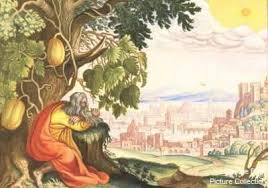Jonah awaiting the destruction of Nineveh
Mount Calvary Church
A Roman Catholic Parish
The Personal Ordinariate of S. Peter
Eutaw Street and Madison Avenue
Baltimore, Maryland
Rev. Albert Scharbach, Pastor
Andrew Johnson, Organist and Music Director
Epiphany III
January 24, 2021
8:00 A.M. Said Mass
10:00 A.M. Sung Mass
This mass will be livestreamed.
__________________
Organ Prelude and Postlude
“Lord Jesus Christ, Be Present Now” arr. Paul Manz
Paul Manz, (1919-2009) was a renowned American organist, conductor, and composer best known for his improvisations and hymn festivals. This suite is in four brief movements, each painting a verse of the German chorale, HERR JESU CHRIST. The final variation sets the tune in compound triple meter, perhaps to represent the Holy Trinity.
_________________
Anthems
Offertory
“How Beautiful Are the Feet of Them from Messiah” G.F. Handel (1685-1759)
“How beautiful are the feet of them that preach the gospel of peace,
and bring glad tidings of good things.”
Handel was a renowned German/English composer of the 18th century, whose popularity far exceeded that of J.S. Bach during their lifetime. Originally an alto duet, the composer later rewrote this aria for solo soprano.
Communion
“Call to Remembrance” Richard Farrant
“Call to remembrance, O Lord,
Thy tender mercy and thy loving kindness
which hath been ever of old.
O remember not the sins and offences of my youth:
but according to thy mercy think thou on me,
O Lord, for thy goodness.”
Richard Farrant (c. 1530-1580) was an English composer and dramatist of the 16th century. Based on the 25th Psalm, this anthem begins with a sweeping gesture of a melodic fifth, pleading for God’s tender mercy and loving kindness.
________________
Hymns
Joyful, joyful, we adore Thee was written ca. 1908, when Henry van Dyke (1852-1953) was a visiting preacher at Williams College, Williamstown, Massachusetts, set in the beautiful landscape of the Berkshire Hills, which is said to have inspired the hymn. Van Dyke, a Presbyterian minister, was also a professor of English literature at Princeton and a friend of President Woodrow Wilson. He served as a naval chaplain in World War I. He composed the words to be sung to the Ode to Joy in Beethoven’s Ninth Symphony. The Ode to Joy theme in the final movement stemmed from a melodic idea Beethoven had hatched in 1790, when he began setting to music a 1785 poem and drinking song by Friedrich Schiller, an die Freude (To Joy).
Fairest Lord Jesus (CRUSADERS HYMN) is a 17th century German, hymn. Three stanzas of this hymn are taken from the version published by Richard Storrs Willis (1819-1900), in his Church Chorals and Choir Studies (New York, 1850). The tune emerges in Franz Liszt’s oratorio Legend of Saint Elizabeth—wherein the tune forms part of the “Crusader’s March”—but no evidence of the tune exists prior to 1842, when the hymn appeared in Schlesische Volkslieder.
Jesus shall reign is by Isaac Watts (1674–1758), who interprets Psalm 72 using a Christological lens. The king referenced in the psalm is Christ, and could be no one else. For Watts, as for the Fathers of the Church, the Old Testament makes sense in light of the New, and vice versa. The tune DUKE STREET was composed by John Warrington Hatton (1710-1793), who supposedly lived on Duke Street in Lancashire, from where his famous tune name comes.
